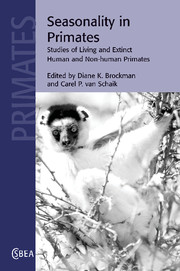Book contents
- Frontmatter
- Contents
- List of contributors
- Preface
- Part I Introduction
- Part II Seasonal habitats
- Part III Seasonality and behavioral ecology
- Part IV Seasonality, reproduction, and social organization
- Part V Seasonality and community ecology
- Part VI Seasonality and human evolution
- 17 Tropical and temperate seasonal influences on human evolution
- 18 Orbital controls on seasonality
- 19 What do studies of seasonality in primates tell us about human evolution?
- Index
- References
18 - Orbital controls on seasonality
Published online by Cambridge University Press: 10 August 2009
- Frontmatter
- Contents
- List of contributors
- Preface
- Part I Introduction
- Part II Seasonal habitats
- Part III Seasonality and behavioral ecology
- Part IV Seasonality, reproduction, and social organization
- Part V Seasonality and community ecology
- Part VI Seasonality and human evolution
- 17 Tropical and temperate seasonal influences on human evolution
- 18 Orbital controls on seasonality
- 19 What do studies of seasonality in primates tell us about human evolution?
- Index
- References
Summary
Introduction
Given the significant influence of seasonality patterns on many aspects of modern human and non-human primate tropical ecology (Foley 1993; Jablonski et al. 2000), it is reasonable to assume that factors associated with seasonality provided key selective forces in the evolution of the human lineage in Equatorial Africa. Reconstructing the climatic and ecological context of early hominin innovations ultimately is critical for interpreting their adaptive significance, and much research has focused on establishing links between hominin evolutionary events and global, regional, and local environmental perturbations (Brain 1981; Grine 1986; Vrba et al. 1989, 1995; Bromage & Schrenk 1999). Attempts to correlate hominin evolution with climatic trends have typically invoked models of progressively more arid and seasonal terrestrial conditions in Africa, ultimately resulting in the expansion of grassland ecosystems. Alternative interpretations of the Pliocene fossil record of east Africa suggest pulses (Vrba 1985) or multiple episodes (Bobe & Eck 2001; Bobe et al. 2002; Bobe & Behrensmeyer 2004) of high faunal turnover correlated with major global climatic change, set within a gradual shift from forest dominance to more open habitats.
While long-term trends or abrupt turnover events may have influenced human evolution, it has become evident that climatic control of mammalian evolution, including hominins, in Equatorial Africa is much more complex than supposed previously and that this region is characterized by almost continuous flux and oscillation of climatic patterns driven primarily by orbital forcing (e.g. Rossignol-Strick et al. 1982; Pokras & Mix 1987; deMenocal 1995; Kutzbach et al. 1996; Thompson et al. 2002; Hughen et al. 2004).
- Type
- Chapter
- Information
- Seasonality in PrimatesStudies of Living and Extinct Human and Non-Human Primates, pp. 519 - 542Publisher: Cambridge University PressPrint publication year: 2005
References
- 5
- Cited by



